Down Syndrome Research and Medical Care Timeline
Click here to view an interactive timeline of Down syndrome research and medical care.
1838
Des Maladies Mentales Considérées Sous les Rapports Médica, Hygiènique et Médico-Légal, written by Jean-Étienne Dominique Esquirol is the first document describing people with intellectual and developmental disabilities, at the time referred to as “idiots,” as being separate from insanity.
Esquirol, J.E.D. (1838). Des maladies meantales considèrèes sous les rspports mèdical, hygiènique et mèdico-lègal (Brussels, J.B. Tircher). http://books.google.com/books?id=WGAGlEePZKQC&printsec=frontcover#v=onepage&q&f=false
1866
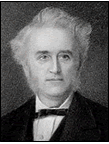
John Langdon Down
English physician and advocate for people with intellectual disabilities, John Langdon Down, links a population with distinct physical characteristics to decreased intellectual ability and calls them “mongoloid” (explaining their facial features were similar to those of the Mongolian people).
1876
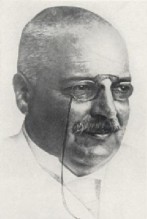
Alois Alzheimer
An initial association between “premature senility” and Down syndrome is made by researchers. It will be 30 years before Alois Alzheimer describes Alzheimer’s disease, and more than 70 years before the association between Down syndrome and Alzheimer’s disease is actually published.
Fraser, M. & Mitchell, A. Kalmyc idiocy. J. Ment. Sci. 22,169–179 (1876).
1929
Life expectancy of someone who is “mongoloid” is only 9 years.
Penrose. L. S. (1949). The incidence of mongolism in the general population. Journal of Mental Science, 95, 685-688.
1932
Non-disjunction is first suggested as a cause of Down syndrome.
1946
Life expectancy of someone who is “mongoloid” is only 12 years.
Penrose. L. S. (1949). The incidence of mongolism in the general population. Journal of Mental Science, 95, 685-688.

Benjamin Spock
Benjamin Spock suggests in Baby and Child Care (1946) that babies born mongoloid should immediately be institutionalized based on the premise that “If [the infant] merely exists at a level that is hardly human, it is much better for the other children and the parents to have him cared for elsewhere” (p. 478).
1948
Evidence for an association between Alzheimer’s and Down syndrome is published.
Jervis, G. A. Early senile dementia in mongoloid idiocy. Am. J. Psychiatry 105, 102–106 (1948).
1950s
1959

Jerome Lejeune
Dr. Jerome Lejeune, a French physician and advocate for people with intellectual disabilities, discovers that being a “mongoloid” is the result of a chromosomal abnormality – three copies of chromosome 21 (instead of two). The term Trisomy 21 starts to gain usage in the medical community to describe people with the condition.
Lejeune, J., Gauthier, M., and Turpin, R. (1959). Études des chromosomes somatiques de neuf enfants mongoliens. CR Acad Sci (Paris) 248, 1721-1722.
1960
The first amniocentesis is used in Copenhagen, Denmark, to determine the sex of a fetus and subsequently abort the fetus as his mother is identified as being a carrier of hemophilia.
Amniocentesis is identified – even while in development – as a potential screening mechanism for Down syndrome.
Researchers discover a type of Trisomy 21 called Translocation.
Polani, P. E. et al. A mongol girl with 46 chromosomes. Lancet 1, 313–324 (1960).
Carter, C. O., Hamerton, J. L., Polani, P. E., Gunalp, E. & Weller, S. D. Chromosome translocation as a cause of familial mongolism. Lancet 2, 678–680 (1960).
1961
Researchers discover a type of Trisomy 21 called Mosaicism.
Clarke, C. M., Edwards, J. H. & Smallpiece, V. 21-trisomy/normal mosaicism in an intelligent child with some Mongoloid characters. Lancet 18, 1028–1030 (1961). 32. Caspersson, T., Zech, L., Johansson,
A prestigious group of 20 biomedical researchers sign a letter to the Lancet objecting to the term “mongolism.” They propose several alternative terms including “Trisomy 21” or “Down syndrome anomaly” (after John Langdon Down).
Allen, G. et al. “Mongolism’’. Lancet 1, 775 (1961).
1965
A delegation from the country of Mongolia sends the World Health Organization an informal request to stop using the objectionable terms of “Mongol” and “Mongoloids” to describe people with Trisomy 21.
The World Health Organization accepts the name Down syndrome as the standard accepted terminology.
The term “mongolism” is removed from most, but not all, references. Mongolism references in scientific literature persist into the 1970s.
Howard-Jones, N. On the diagnostic term ‘‘Down’s disease’’. Med. Hist. 23, 102–104 (1979).
1968
Down syndrome is first detected using a form of amniocentesis that is later abandoned due to health risks. Amnios do not come into common use in the United States until safety trials are completed in 1976.
Researchers in Copenhagen begin experimenting with chorionic villi sampling in an attempt to identify genetic conditions, including Down syndrome, in the first trimester of pregnancy.
Hahnmemann, N., & Mohr, J. (1969). Antenatal foetal diagnosis in genetic disease. Bulletin of European Social and Human Genetics, 3, 47
1970s
Life expectancy of someone with Down syndrome is only 25 years.
1974
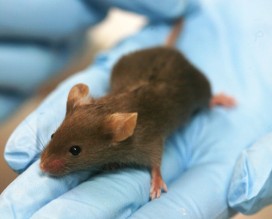 The first mouse model of Down syndrome, Ts16, is created.
The first mouse model of Down syndrome, Ts16, is created.
Neibuhr shows that Down syndrome might be pathogenetic.
Neibuhr, E. (1974). The possibility of a pathogenetic segment on chromosome 21. Humangenetik 21, 99-101.
1975
A new systematic model for studying trisomy, including Down syndrome, in mice is published. Ts16 was the only mouse model that had previously existed. This new approach created guidelines for studying other chromosomal abnormalities.
Gropp, A., Kolbus, U., and Giers, D. (1975). Systematic approach to the study of trisomy in the mouse. Cytogenet Cell Genet 14, 42-62.
1976
Amniocentesis comes into common use in the United States and the first abortions after midtrimester amnios are reported.
1978
Parents of a child born with a disability sue for malpractice when an obstetrician fails to refer a patient over the age of 35 for amniocentesis.
Rogers T. D. (1982). Wrongful life and wrongful birth: Medical malpractice in genetic counseling and prenatal testing. Science Law Review, 33, 713.
1979
Research is published that describes the impact of stimulation on infants and children with Down syndrome and compares the IQs of children raised in institutions versus those raised at home. Children with Down syndrome raised in institutions had an average IQ of 20 to 30, while those raised at home with no specific attention to stimulation averaged about 40, and those raised at home with stimulation had an average IQ of 55. This study also found that IQ declines with age in people with Down syndrome, regardless of their environment.
The SOD-1 gene is mapped to chromosome 16 in mice. This is the first chromosome HSA21 to be mapped in mice.
Francke, U., and Taggart, R.T. (1979). Assignment of the gene for cytoplasmic superoxide dismutase (Sod-1) to a region of chromosome 16 and Hprt to a region of the X chromosome in the mouse. Proc Natl Acad Sci USA 76, 5230-5233.
1980
Ts16 is proposed as a mouse model for Down syndrome. However, these mice die at or near birth. It will be more than 10 years before a viable mouse model of Down syndrome is created.
Polani, P., E. & Adinolfi, M. Chromosome 21 of man, 22 of the great apes and 16 of the mouse. Dev. Med Child Neurol. 22, 223–233 (1980)
A second chromosome Hsa21 gene is mapped in a mouse to chromosome 16, by Frank Ruddle and P.F. Lin.
Lin, P.F., Slate, D.L., Lawyer, F.C., and Ruddle, F.H. (1980). Assignment of the murine interferon sensitivity and cytoplasmic superoxide dismutase genes to chromosome 16. Science 209, 285-287.
1981
“Down Syndrome Preventative Medical Checklist,” edited by William I. Cohen, presents the first U.S. medical management suggestions for doctors treating people with Down syndrome. Its updated 1999 version is still used today.
1983
Life expectancy of a person with Down syndrome is 25 years.
The American Congress of Obstetrics and Gynecologists and the American Academy of Pediatrics advise their members that women over the age of 35 should be offered prenatal testing for Down syndrome and other genetic disorders.
American Academy of Pediatrics and American Congress of Obstetricians and Gynecologists. (1983). Guidelines for perinatal care.
Research published in the Journal of American Medical Association indicates at the age of 35, the risk of having a baby with a chromosome problem was about 1 in 200 (or half of 1%) and the risk of having a miscarriage from an amniocentesis was thought to be about 1 in 200 (or half of 1%). Therefore the age of 35 was picked as the “cutoff” for diagnostic testing because the chance of finding a problem was the same as the chance of causing a problem.
1984
The possibility of a less invasive, 12-week diagnostic blood test to detect a fetus with Down syndrome becomes a reality as researchers identify certain biochemical markers in a pregnant woman’s blood associated with Down syndrome. Despite 27 years and hundreds of millions of dollars of investment, there is still no such test available today.
1986

Charles Epstein
Charles Epstein publishes The consequences of chromosome imbalance: Principles, mechanisms, and models, an influential book on principles for studying Down syndrome.
Epstein, C. (1986). The consequences of chromosome imbalance: Principles, mechanisms, and models (Cambridge, Cambridge University Press).
Groner and Elroy-Stein create mouse cells that overproduce SOD1 and show that three copies of SOD1 may contribute to some of the features of Down syndrome.
Elroy-Stein, O., Bernstein, Y., and Groner, Y. (1986). Overproduction of human Cu/Zn-superoxide dismutase in transfected cells: extenuation of paraquat-mediated cytotoxicity and enhancement of lipid peroxidation. Journal of the European Molecular Biology Organization 5, 615-622.
1987
A gene strongly associated with Alzheimer’s disease is discovered on Chromosome 21.
Goldgaber D, Lerman MI, McBride OW, Saffiotti U, Gajdusek DC.
Characterization and chromosomal localization of a cDNA encoding brain amyloid of Alzheimer’s disease. Science. 1987 Feb 20;235(4791):877-80.
1989
Several groups (Delabar, McCormick and Antonarakis, Rahmani and Delabar) attempt to define a minimal region of chromosome HSA21, a “Down syndrome critical region” that is necessary to cause Down syndrome. It is hoped that this will narrow the search for critical genes.
Delabar JM, Sinet PM, Chadefaux B, Nicole A, Gegonne A, Stehelin D, Fridlansky F, Créau-Goldberg N, Turleau C, de Grouchy J. Submicroscopic duplication of chromosome 21 and trisomy 21 phenotype (Down syndrome). Hum Genet. 1987 Jul;76(3):225-9.
McCormick MK, Schinzel A, Petersen MB, Stetten G, Driscoll DJ, Cantu ES, Tranebjaerg L, Mikkelsen M, Watkins PC, Antonarakis SE. Molecular genetic approach to the characterization of the “Down syndrome region” of chromosome 21. Genomics. 1989 Aug;5(2):325-31.
Rahmani Z, Blouin JL, Creau-Goldberg N, Watkins PC, Mattei JF, Poissonnier M, Prieur M, Chettouh Z, Nicole A, Aurias A, et al. Critical role of the D21S55 region on chromosome 21 in the pathogenesis of Down syndrome. Proc Natl Acad Sci U S A. 1989 Aug;86(15):5958-62.
1990

Muriel T. Davisson, Ph.D
Muriel T. Davisson and researchers at The Jackson Laboratory develop the Ts65Dn mouse model, with an extra chromosome and characteristics similar to those found in humans with Down syndrome. This model will replace the Ts16 mouse for the majority of Down syndrome research and, although only a partial trisomy, it will be the best mouse model of Down syndrome for more than 15 years.
Davisson MT, Schmidt C, Akeson EC. 1990. Segmental trisomy of murine chromosome 16: A new model system for studying Down syndrome. In: Molecular Genetics of Chromosome 21 and Down Syndrome, Epstein C, Patterson D (eds), Wiley-Liss, Inc, New York, Progress in Clinical and Biological Research 360:263-280.
1992
Dr. Brian Chicoine and Dr. Dennis McGuire establish the Adult Down Syndrome Center of Lutheran General Hospital. The center is the first comprehensive adult clinic that sees patients with Down syndrome daily. Today the center sees more than 4,000 patients locally each year.
1994
Centers for Disease Control (CDC) announce the prevalence of Down syndrome from 1983 – 1990 was 1 in 1087.
Further analysis of chromosome Hsa21 in several people with Down syndrome caused by partial trisomy demonstrates that the “Down syndrome critical region” is not a valid definition and that genes mapping all over chromosome HSA21 may contribute to features of Down syndrome, including intellectual disability.
Korenberg JR, Chen XN, Schipper R, Sun Z, Gonsky R, Gerwehr S, Carpenter N, Daumer C, Dignan P, Disteche C, et al. Down syndrome phenotypes: the consequences of chromosomal imbalance. Proc Natl Acad Sci U S A. 1994 May 24;91(11):4997-5001.
1995
American Academy of Family Physicians creates its Healthcare Management of Adults with Down Syndrome guidelines to assist physicians with the ongoing healthcare needs of adults with Down syndrome. It is updated in 2001.
The Ts65Dn mouse model is shown to have deficits in learning and memory relevant to those seen in Down syndrome.
Reeves, R., Irving, N., Moran, T., Wohn, A., Kitt, C., Sisodia, S., Schmidt, C., Bronson, R., and Davisson, M. (1995). A mouse model for Down Syndrome exhibits learning and behaviour deficits. Nature Genetics 11, 177-183.
1996
Information about comorbidities in people with Down syndrome is established for heart defects, hypothyroidism, and hearing impairments.
The Down Syndrome Medical Interest Group is founded. This is a group of healthcare professionals and doctors dedicated to spreading the information of the medical aspects of those with Down syndrome and to promote specialization in the field.
About DSMIG. (n.d.). Retrieved from The Down’s Syndrome Medical Interest Group website: http://www.dsmig.org.uk/aboutdsmig/index.html
1997
Life expectancy of a person with Down syndrome is 49 years.
National Institute of Child Health and Human Development (NICHD) and the National Institute of Neurological Diseases and Stroke (NINDS) co-fund six Down syndrome research grants representing over $3 million over a multi-year period in conjunction with the National Down Syndrome Society.
Patricia C. Winders publishes the first and definitive book on gross motor skills, Gross Motor Skills For Children With Down Syndrome: A Guide for Parents and Professionals. The evidence-based therapies can mean the difference between walking and playing sports versus a lifetime of hip and knee problems.
Another mouse model for Down syndrome, Ts1Cje, is developed that exhibits learning deficits and behavior abnormalities that are relevant to those seen in people with Down syndrome.
Sago, H., Carlson, E.J., Smith, D.J., Kilbridge, J., Rubin, E.M., Mobley, W.C., Epstein, C.J., and Huang, T.T. (1998). Ts1Cje, a partial trisomy 16 mouse model for Down syndrome, exhibits learning and behavioral abnormalities. Proc Natl Acad Sci U S A 95, 6256-6261.
1999
“Down Syndrome Preventative Medical Checklist,” edited by William I. Cohen, is revised for the first time since 1981. It is still used today.
2000
Scientists succeed in mapping the smallest human chromosome, chromosome 21. This is the second fully deciphered human chromosome. The consequences of the new information on the genes of chromosome 21 for the study of Down syndrome are elucidated.
Hattori, M. et al. The DNA sequence of human chromosome 21. Nature 405, 311–319 (2000).
Gardiner K, Davisson M. The sequence of human chromosome 21 and implications for research into Down syndrome. Genome Biol. 2000;1(2):REVIEWS0002. Epub 2000 Aug 4.
2001
National Institutes of Health (NIH) funding for Down syndrome research is $29 million out of a $20.5 billion dollar budget, or 0.0014 percent of the overall budget.
American Academy of Pediatrics creates Health Supervision for Children with Down Syndrome guidelines designed to assist pediatricians in caring for children with Down syndrome. These guidelines entail counseling for the mother and care of the child during infancy.
American Academy of Family Physicians updates Healthcare Management of Adults with Down Syndrome guidelines to assist physicians with ongoing healthcare needs of adults with Down syndrome.
Sally Shot begins a five-year sleep pattern study on children with Down syndrome between the ages of 2-4 years old. This groundbreaking research shows that 57% of children in the study express abnormal sleep patterns, many have sleep apnea. Her work inspires other research on sleep apnea and children with Down syndrome.
A piece of the Down syndrome critical region that is shared between mice and humans is cloned and sequenced. The sequenced region has 34 expressed genes, 19 of which were previously unknown. Comparative mapping by DNA sequencing is a powerful new tool to understand candidate genes involved in Down syndrome.
Pletcher, M. T., Wiltshire, T., Cabin, D. E., Villanueva, M., & Reeves, R. H. (2001, April 20). Use of Comparative Physical and Sequence Mapping to Annotate Mouse Chromosome 16 and Human Chromosome 21. Genomics, 74, 45-54. doi:10.1006/geno.2001.6533
2002
Funding for research for people with Down syndrome at the National Institutes of Health (NIH) begins its free-fall with cuts for several consecutive years, in some years the largest cuts for any condition in the US.
Cincinnati Children’s Hospital Medical Center opens The Jane and Richard Thomas Center for Down Syndrome. It is the first center in the U.S. providing children with Down syndrome comprehensive and daily evaluation, treatment, research, and education.
Several researcher groups continue to identify chromsome HSA21 genes, their functions, and how they may contribute to the features of Down syndrome.
Reymond A, Camargo AA, Deutsch S, Stevenson BJ, Parmigiani RB, Ucla C, Bettoni F, Rossier C, Lyle R, Guipponi M, de Souza S, Iseli C, Jongeneel CV, Bucher P, Simpson AJ, Antonarakis SE. Nineteen additional unpredicted transcripts from human chromosome 21. Genomics. 2002 Jun;79(6):824-32.
Gardiner K, Slavov D, Bechtel L, Davisson M. Annotation of human chromosome 21 for relevance to Down syndrome: gene structure and expression analysis. Genomics. 2002 Jun;79(6):833-43.
2003
National Institutes of Health (NIH) funding for Down syndrome research is $23 million out of a $27.1 billion dollar budget, or 0.0008 percent of the overall budget.
2004
National Institutes of Health (NIH) funding for Down syndrome research is $19 million out of a $27.9 billion dollar budget, or 0.0007 percent of the overall budget.
Another mouse model is created by Reeves and colleagues. This mouse is trisomic only for the “Down syndrome critical region” and fails to show important features associated with Down syndrome.
Olsen, L. E., Richtsmeier, J. T., Leszl, J., & Reeves, R. H. (2004, October 22). A Chromosome 21 Critical Region Does Not Cause Specific Down Syndrome Phenotypes. Science, 306(5696), 687-690. doi:10.1126/science.1098992
Granholm and colleagues demonstrate the first use of a drug treatment to prevent development of a Down syndrome feature in the Ts65Dn mouse model. The drug used is minocycline, an anti-inlflammatory. Minocycline prevents the degeneration of brain cells in the Ts65Dn that occurs with age in Down syndrome and that is considered to be a hallmark of Alzheimer’s Disease.
Hunter CL, Bachman D, Granholm AC. Minocycline prevents cholinergic loss in a mouse model of Down’s syndrome. Ann Neurol. 2004 Nov;56(5):675-88.
2005
Anna and John J. Sie Foundation launches the “Breakthrough Research Initiative Summit” with leading scientists outside of the Down syndrome research community as well as from within weighing in on whether medical and cognitive breakthrough for people with Down syndrome is viable within ten years. The conclusions of the summit will set the Sie family’s focus on research and medical care for people with Down syndrome.
Hunt and Hodges provide the first evidence that insufficient cohesin is a cause of age-related aneuploidy. Additionally the study provides a possible cause for this deficient cohesin.
Hodges, C.A., Revenkova, E., Jessberger, R., Hassold, T.J., and Hunt, P.A. (2005). SMC1beta-deficient female mice provide evidence that cohesins are a missing link in age-related nondisjunction. Nat Genet 37, 1351-1355.
National Institutes of Health (NIH) funding for Down syndrome research is $15 million out of a $28.5 billion dollar budget, or 0.0005 of the overall budget.
National Institutes for Health (NIH) and the National Institute of Child Health and Development (NICHD) provide funding for nuchal translucency prenatal testing.
Fisher and colleagues develop a new mouse model of Down syndrome by inserting a human chromosome 21 into mouse cells. This mouse is trisomic for many HSA21 genes that are not trisomic in the Ts65Dn model and provides a way to study the possible contributions of these genes to the features of Down syndrome.
O’Doherty A, Ruf S, Mulligan C, Hildreth V, Errington ML, Cooke S, Sesay A, Modino S, Vanes L, Hernandez D, Linehan JM, Sharpe PT, Brandner S, Bliss TV, Henderson DJ, Nizetic D, Tybulewicz VL, Fisher EM. An aneuploid mouse strain carrying human chromosome 21 with Down syndrome phenotypes. Science. 2005 Sep 23;309(5743):2033-7.
2006
Life expectancy of a person with Down syndrome is approximately 60 years.
Down syndrome becomes the least-funded major genetic condition by the National Institutes of Health (NIH). Funding for Down syndrome research hits an all-time low of $14 million, or 0.0005 percent of the NIH’s $28.5 billion budget.
Newborn Ts65Dn mice are treated with a chemical to activate Sonic hedgehog proteins. This substantially prevents the development of the Down syndrome cerebellar phenotype seen in these mice.
Roper, R.J., Baxter, L.L., Saran, N.G., Klinedinst, D.K., Beachy, P.A., and Reeves, R.H. (2006). Defective cerebellar response to mitogenic Hedgehog signaling in Down syndrome mice. Proc Natl Acad Sci U S A 103, 1452-1456.
Dr. Francis Hickey and Bonnie Patterson co-author a paper increasing awareness about the dual diagnosis Down syndrome and autism.
Anna and John J. Sie Foundation organizes the “Sie Family Research Summit on Down Syndrome” soliciting breakthrough scientific research proposals from researchers. The foundation funds $1 million worth of the proposals in cooperation with the University of Colorado.
The Ts65Dn and other mouse models of Down syndrome continue to provide important molecular and behavioral information that may be relevant for understanding Down syndrome.
Sérégaza Z, Roubertoux PL, Jamon M, Soumireu-Mourat B. Mouse models of cognitive disorders in trisomy 21: a review. Behav Genet. 2006 May;36(3):387-404.
2007
National Institutes of Health (NIH) funding for Down syndrome research is $16 million out of a $29 billion dollar budget, or 0.0006 percent of the overall budget.
The National Institutes of Health (NIH) develops and issues a research plan to advance understanding of Down syndrome and speed development of new treatments. The plan sets research goals for the next 10 years that build upon earlier research advances fostered by the NIH.
The American Congress of Obstetricians and Gynecologists (ACOG) issues a new recommendation that all pregnant women, regardless of their age, should be offered prenatal screening for Down syndrome and other genetic disorders. This changed ACOGs long-standing recommendation to offer such prenatal testing only to pregnant women 35 years or older.
Fabian Fernandez and Craig Garner describe treatment of the Ts65Dn mouse model with GABAA antagonists. Thes drugs provided long term rescue of learning and memory deficits. The authors suggest using these drugs as a therapy for humans with Down syndrome, however, caution is needed because these drugs cause seizures, although at higher doses than used in the mice..
Fernandez, F., Morishita, W., Zuniga, E., Nguyen, J., Blank, M., Malenka, R. C., & Garner, C. C. (2007, February 25). Pharmacotherapy for cognitive impairment in a mouse model of Down syndrome. Nature Neuroscience, 10, 411-413. doi:10.1038/nn1860
2008
Linda Crnic Institute for Down Syndrome, the first academic home for Down syndrome, is created with a generous contribution from the Anna and John J. Sie Foundation. The Institute is located on the University of Colorado Anschutz Medical Campus and is a unique partnership with University of Colorado Boulder, University of Colorado School of Medicine, and Children’s Hospital Colorado.
Memantine (an FDA-approved drug) is shown to rescue specific learning and memory deficits in Ts65Dn mice.
Costa, A.C., Scott-McKean, J.J., and Stasko, M.R. (2008). Acute injections of the NMDA receptor antagonist memantine rescue performance deficits of the Ts65Dn mouse model of Down syndrome on a fear conditioning test. Neuropsychopharmacology 33, 1624-1632.
It is proposed that the same mechanisms that cause aneuploidy, particularly in chromosome 21, among those with Down syndrome may be responsible for the development of sporadic and genetic forms of Alzheimer’s disease.
Potter, H. (2008, January). Down’s syndrome and Alzheimer’s disease: two sides of the same coin. Future Medicine 3(1), 29-37. doi:10.2217/14796708.3.1.29
2009
National Institutes of Health (NIH) funding for Down syndrome research is $18 million out of a $30.2 billion dollar budget, or 0.0006 percent of the overall budget.
Based on information that EGCG, a compound found in green tea leaves, inhibits the activity of the chromosome HSA21 gene, DYRK1A, Delabar and colleagues use it to treat mice that were engineered to overproduce DYRK1A. They show that EGCG eliminates the learning and memory deficits seen in that mouse..
Guedj, F., Sebrie, C., Rivals, I., Ledru, A., Paly, E., Bizot, J.C., Smith, D., Rubin, E., Gillet, B., Arbones, M., et al. (2009). Green tea polyphenols rescue of brain defects induced by overexpression of DYRK1A. PLoS One 4, e4606.
Official guidelines for managing sleep apnea are released to be used by healthcare professionals. Most or all individuals with Down syndrome have sleep apnea.
Epstein LJ, Kristo D, Strollo PJ Jr, Friedman N, Malhotra A, Patil SP, Ramar K, Rogers R, Schwab RJ, Weaver EM, Weinstein MD (2009, June 15). Adult Obstructive Sleep Apnea Task Force of the American Academy of Sleep Medicine. Clinical guideline for the evaluation, management and long-term care of obstructive sleep apnea in adults. J Clin Sleep Med, 5(3), 263-76.
National Institutes of Health (NIH) dedicates $4 million dollars of stimulus funds received from the American Recovery and Reinvestment Act (ARRA) to Down syndrome research.
Centers for Disease Control (CDC) announces that the prevalence of Down syndrome is increasing based on a review of data from 1979 – 2003.
2010
National Institutes of Health (NIH) funding for Down syndrome research is $22 million out of a $30.9 billion dollar budget, or 0.0007 percent of the overall budget.
The National Institutes of Health (NIH) dedicates $6 million dollars of stimulus funds received from the American Recovery and Reinvestment Act (ARRA) to Down syndrome research.
Aβ-induced microtubule dysfunction is shown to cause aneuploidy and is therefore thought to contribute to pathogenesis of Alzheimer’s disease.
Granic, A., Padmanabhan, J., Norden, M., Potter, H. (2010, February 15). Alzheimer Aβ Peptide Induces Chromosome Mis-Segregation and Aneuploidy, Including Trisomy 21: Requirement for Tau and APP. Mol. Biol. Cell 21(4), 511-520. doi:10.1091/mbc.E09-10-0850
Global Down Syndrome Foundation and the National Institute of Child Health and Human Development (NICHD) co-organize and co-fund the first National Institutes of Health (NIH) conference on Down syndrome – Down Syndrome: National Conference on Patient Registries, Research Databases and Biobanks.
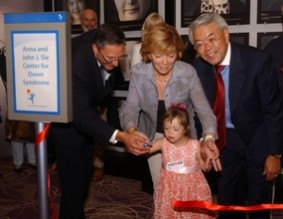
Anna and John J. Sie, with their granddaughter and Jim Shmerling (president of Children's), at the opening of the Sie Center.
Upon hiring renowned Down syndrome expert Dr. Francis Hickey, the Anna and John J. Sie Center for Down Syndrome opens its doors to patients with Down syndrome from throughout the world and in the US.
Jamie Edgin and Lynn Nadel assemble and validate a battery of tests for evaluating cognition in individuals with Down syndrome. This tool, the Arizona Cognitive Test Battery, is crucial for standardizing the assessment of the effectiveness of cognition enhancing drugs for Down syndrome.
Edgin, J. O., Mason, G. M., Allman, M. J., Capone, G. T., DeLeon, I., Maslen, C., . . . Nadel, L. (2010, July 10). Development and validation of the Arizona Cognitive Test Battery for Down syndrome. Journal of Neurodevelopmental Disorders, 2(3), 149-164. doi:10.1007/s11689-010-9054-3
A new, complete trisomy mouse model of Down syndrome is engineered by T. Yu and colleagues. For the first time, the effects of trisomy of all chromosome HSA21 genes can be assessed. Yu also shows that trisomy of sets of genes not present in the Ts65Dn model also lead to learning and memory deficits similar to those seen in Down syndrome.
Yu T, Li Z, Jia Z, Clapcote SJ, Liu C, Li S, Asrar S, Pao A, Chen R, Fan N, Carattini-Rivera S, Bechard AR, Spring S, Henkelman RM, Stoica G, Matsui S, Nowak NJ, Roder JC, Chen C, Bradley A, Yu YE (2010) A mouse model of Down syndrome trisomic for all human chromosome 21 syntenic regions. Hum Mol Genet 19, 2780-2791.
Yu T, Liu C, Belichenko P, Clapcote SJ, Li S, Pao A, Kleschevnikov A, Bechard AR, Asrar S, Chen R, Fan N, Zhou Z, Jia Z, Chen C, Roder JC, Liu B, Baldini A, Mobley WC, Yu YE. Effects of individual segmental trisomies of human chromosome 21 syntenic regions on hippocampal long-term potentiation and cognitive behaviors in mice. Brain Res. (2010) 1366:162-171.
2011
NIH forms the Down Syndrome Consortium.
Official guidelines for how genetic counselors can better assist and guide parents who receive news they are pregnant with or have a newborn with Down syndrome are released.
Sheets KB, Crissman BG, Feist CD, Sell SL, Johnson LR, Donahue KC, Masser-Frye D, Brookshire GS, Carre AM, LaGrave D, Brasington CK (2011, October). Practice guidelines for communicating a prenatal or postnatal diagnosis of Down syndrome: recommendations of the National Society of Genetic Counselors. J Genet Couns, 20(5), 432-41.
As a result of the Down Syndrome: National Conference on Patient Registries, Research Databases and Biobanks, the National Institutes of Health (NIH) issue a Request for Information asking for public input on a centralized Down syndrome contract registry, research database, and biobank.
It is discovered that the proteins commonly found in the brains of patients with Alzheimer’s disease and that are thought to play a role in the development of the disease may also affect mitosis. This is thought to cause aneuploidy, which can cause irregular numbers of chromosomes in daughter cells. It has been shown that all individuals with Down syndrome will develop some of the physical signs of Alzheimer’s, but not all will experience related memory loss.
Borysov, S., Granic, A., Padmanabhan, J., Walczak, C., Potter, H. (2011, May 1). Alzheimer Aβ disrupts the mitotic spindle and directly inhibits mitotic microtubule motors. Cell Cycle, 10(9), 1-14.
By 2011, a total of ten different drug treatments have been shown to correct learning and memory deficits and some cellular abnormalities in the Ts65Dn mouse model of Down syndrome. The drugs have very different properties and many are FDA-approved, spurring interest in pursuing clinical trials.
Chang Q, Gold PE. Age-related changes in memory and in acetylcholine functions in the hippocampus in the Ts65Dn mouse, a model of Down syndrome. Neurobiol Learn Mem. 2008 89:167-77.
Bianchi P, Ciani E, Guidi S, Trazzi S, Felice D, Grossi G, Fernandez M, Giuliani A, Calzà L, Bartesaghi R. (2010) Early pharmacotherapy restores neurogenesis and cognitive performance in the Ts65Dn mouse model for Down syndrome. J Neurosci.30:8769-8779.
Lockrow, J. et al. (2009) Cholinergic degeneration and memory loss delayed by vitamin E in a Down syndrome mouse model. Exp Neurol. 216, 278-289.
Salehi A, Faizi M, Colas D, Valletta J, Laguna J, Takimoto-Kimura R, Kleschevnikov A, Wagner SL, Aisen P, Shamloo M, Mobley WC. (2009) Restoration of norepinephrine-modulated contextual memory in a mouse model of Down syndrome. Sci Transl Med. 1, 7ra17.
Braudeau J, Delatour B, Duchon A, Pereira PL, Dauphinot L, de Chaumont F, Olivo-Marin JC, Dodd RH, Hérault Y, Potier MC. Specific targeting of the GABA-A receptor α5 subtype by a selective inverse agonist restores cognitive deficits in Down syndrome mice. J Psychopharmacol. (2011) 25:1030-42.
Incerti M, Toso L, Vink J, Roberson R, Nold C, Abebe D, Spong CY. Prevention of learning deficit in a Down syndrome model. Obstet Gynecol. (2011) 117:354-61.
Gardiner, KJ (2010) Molecular basis of pharmacotherapies for cognition in Down syndrome. Trends Pharmacol Sci. 31, 66-73.
Centers for Disease Control (CDC) updates its prevalence estimates of Down syndrome to 1 in 691 live births.
Gene Security Network receives $2 million grant from NIH to fund clinical trials to apply parental support for non-invasive prenatal diagnosis.
2012
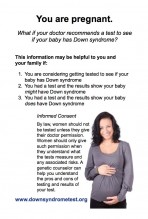 Global Down Syndrome Foundation and National Down Syndrome Congress publish a prenatal testing pamphlet called “You are pregnant. What if your doctor recommends a test to see if your baby has Down syndrome?” and start a national distribution campaign in order to ensure that pregnant women receive accurate information at the time of diagnosis, as required by the 2008 Prenatally and Postnatally Diagnosed Condition Awareness Act.
Global Down Syndrome Foundation and National Down Syndrome Congress publish a prenatal testing pamphlet called “You are pregnant. What if your doctor recommends a test to see if your baby has Down syndrome?” and start a national distribution campaign in order to ensure that pregnant women receive accurate information at the time of diagnosis, as required by the 2008 Prenatally and Postnatally Diagnosed Condition Awareness Act.


 Experience our inspirational and groundbreaking videos and photos. Our children and self-advocates are beautiful AND brilliant!
Experience our inspirational and groundbreaking videos and photos. Our children and self-advocates are beautiful AND brilliant! Make sure your local Representatives are on the Congressional Down Syndrome Task Force.
Make sure your local Representatives are on the Congressional Down Syndrome Task Force.